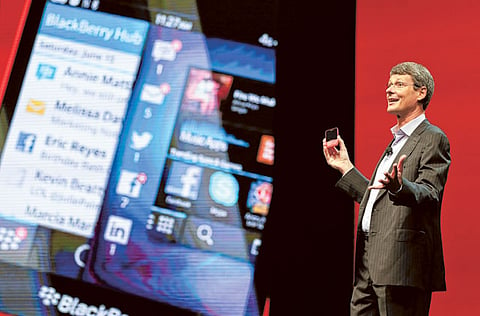Cheaper BlackBerry takes aim at emerging markets
CEO Thorsten Heins says the time is right to offer BBM on rival devices.

Orlando: Research In Motion unveiled a lower-cost BlackBerry aimed at consumers in emerging markets on Tuesday, and said it will offer its once-popular BlackBerry Messenger service on iPhones and devices running Google’s Android software.
CEO Thorsten Heins said the time is right to offer BBM on rival devices. He said iPhone and Android versions will be available for free, subject to approval by Google Play and the Apple App Store.
“It’s time to bring BBM to a greater audience,” Heins said. “I cannot wait for the day when all of our BlackBerry fans can send BBM invites to all their friends on other platforms. They have asked us for this for years.”
The BBM service was once a reason for BlackBerry users not to defect to other smartphones. Now, there are many rival messaging services. Still, there are more than 60 million BBM users worldwide.
The lower-cost Q5 device will be available in Europe, the Middle East, Africa, Asia (including the Asia Pacific region), and Latin America beginning in July. The higher-tier Q10 has been released in most markets, but US carriers likely won’t have it until June after a delay.
The gadget is part of RIM’s effort to regain market share lost to Apple’s iPhone and Android smartphones. It is the company’s third smartphone to run the new BlackBerry 10 system. The Q5 will have a physical keyboard, something that sets RIM’s devices apart from Apple’s iPhone and most Android phones.
The US delay in selling the new keyboard BlackBerry complicates RIM’s efforts to hang on to customers tempted by Apple’s iPhone and a range of Android smartphones. Even as the BlackBerry has fallen behind rivals in recent years, many BlackBerry users have remained loyal because they prefer a physical keyboard over the touch screen found on the iPhone and most Android devices.
Heins said the “slim, sleek” device will be available in red, black, white and pink. He announced the phone to a packed ballroom to open RIM’s annual three-day conference in Orlando, Florida.
The Q5 differs only slightly from the Q10 overall. Both have 2GB of RAM, though the Q5 has only 8GB of flash memory compared to 16 for the Q10. Both have 2 megapixel front-facing cameras, but the Q5’s rear-facing camera is only 5 megapixels, compared to the Q10 which has 8 megapixels and also records high-definition video.
Also, the Q5 has a 3.1-inch LCD display, while the Q10 is 3.1 inches and LED.
RIM unveiled new BlackBerrys this year after delays allowed Apple and others to dominate.
Heins, who became RIM’s CEO in January 2012, said the company has made a lot of progress in a short period of time, by moving a diverse collection of people into leadership positions.
He restated BlackBerry’s committed to “mobile first” and took a subtle jab at industry predictions that he might not make it to this year’s conference as CEO because of the competitive mobile landscape.
“I’m happy to say they were wrong,” Heins said. “We are not only still here. We are firing on all cylinders as a company.”
RIM’s iconic BlackBerry device, introduced in 1999, was the dominant smartphone for on-the-go business people and consumers before the iPhone debuted in 2007. The device showed that phones could handle much more than email and calls.
Though RIM continues to do well in many overseas markets, the company faced numerous delays modernizing its operating system in an effort to compete with the iPhone and smartphones running Google’s Android operating system.
RIM’s stock fell 30 cents, or 1.9 percent, to $15.58 in morning trading Tuesday.
Heins wouldn’t discuss what BlackBerry’s current earnings are, instead deferring to the quarterly report to be released at the end of June.
Heins also said that RIM is “definitely in the race” and that he is excited about its outlook, predicting the most successful year for BlackBerry.
“What I can say is that 12 months ago I was told we would be out of business in two quarters, and that we could burn through our cash within two quarters. It didn’t happen. We are confident in the future of BlackBerry 10.”
Asked about a move away from tablet technology, Heins said that the future is in mobile and that BlackBerry’s new initiatives are to target a consumer it thinks will rely on one mobile device for all communications within seven years.
RIM’s tablet, the Playbook, has not sold well.
“You will always have people that are in a very limited view (asking questions) like ‘when are you going to take on Apple?’” Heins said. “That’s not the way I’m thinking about this.”
Grammy Award-winning singer Alicia Keys, who was named BlackBerry’s global creative director in January, announced the company’s new BlackBerry Scholars Program. The new initiative will begin this year and provide scholarships in science-based studies for students around the globe.
“I was inspired. I wanted to take this journey with BlackBerry,” Keys said.
The scholarship programme hopes to attract women, who Keys said make up more than half of mobile users.
“It’s the beginning for a powerful network of women and a profound change in our culture,” she said.
Colin Gillis, an analyst at BGC Partners, said offering BBM on rival platforms is a good move because closed ecosystems don’t work anymore. He said the company was forced to do it but said it might be too late.
“BBM is a communication network and it’s only as powerful as people who are on it,” Gillis said.
Sign up for the Daily Briefing
Get the latest news and updates straight to your inbox



